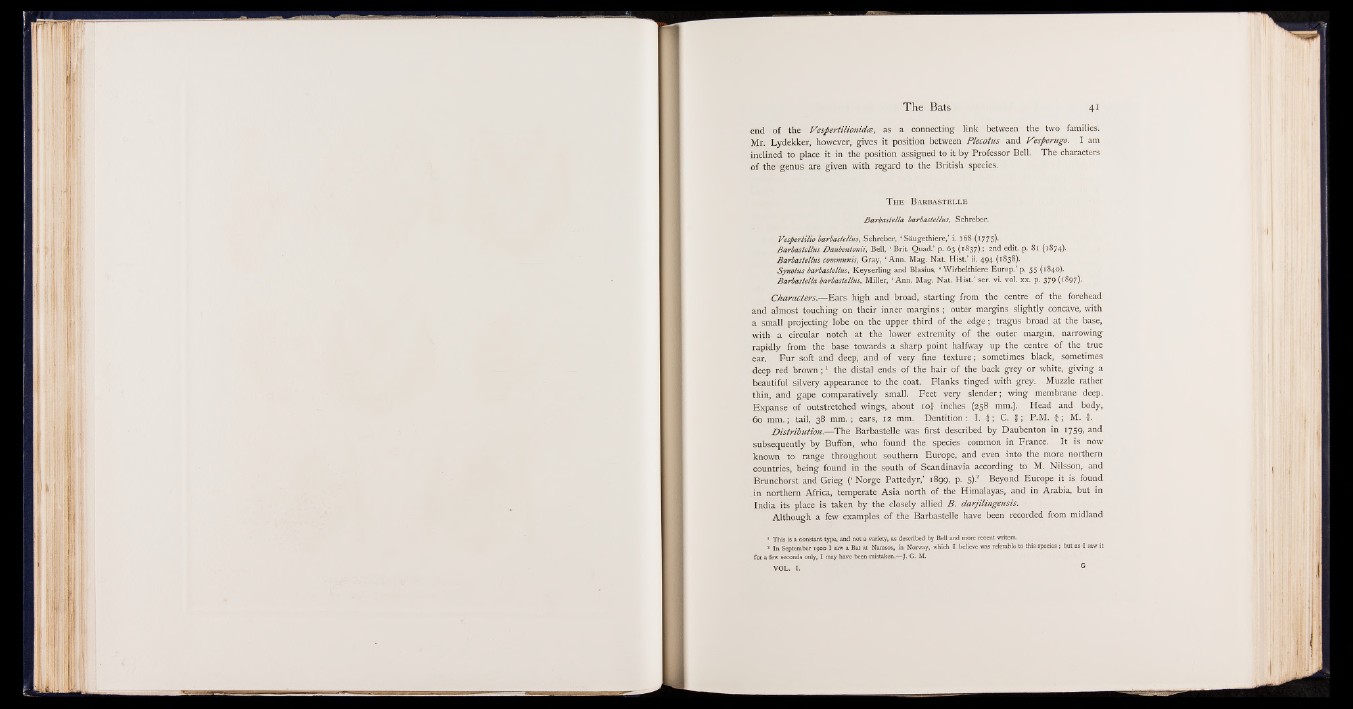
end of the Vespertilionida, as a connecting link between the two families.
Mr. Lydekker, however, gives it position between Plecotus and Vesperugo. I am
inclined to place it in the position assigned to it by Professor Bell. The characters
of the genus are given with regard to the British species.
T h e B a r b a s t e l l e
Barbastella barbastellus, Schreber.
Vespertilio barbastellus, Schreber, ‘ Saugethiere,’ i. 168 (177 5)-
Barbastellus Daubentonii, Bell, ‘ Brit. Quad.’ p. 63 (1837); 2nd edit. p. 81 (1874),
Barbastellus communis, Gray, ‘ Ann. Mag. Nat. Hist.’ ii. 494 (1838).
Synotus barbastellus, Keyserling and Blasius, ‘ Wirbelthiere Europ.’ p. 55 (1840).
Barbastella barbastellus, Miller, ‘ Ann. Mag. Nat. Hist.’ ser. vi. vol. xx. p. 379 ( i 897)-
Characters.— Ears high and broad, starting from the centre of the forehead
and almost touching on their inner margins; outer margins slightly concave, with
a small projecting lobe on the upper third of the edge; tragus broad at the base,
with a circular notch at the lower extremity of the outer margin, narrowing
rapidly from the base towards a sharp point halfway up the centre of the true
ear. Fur soft and deep, and of very fine texture; sometimes black, sometimes
deep red brown ; 1 the distal ends of the hair of the back grey or white, giving a
beautiful silvery appearance to the coat. Flanks tinged with grey. Muzzle rather
thin, and gape comparatively small. Feet very slender; wing membrane deep.
Expanse of outstretched wings, about 10& inches (258 mm.). Head and body,
60 mm.; tail, 38 mm.; ears, 12 mm. Dentition: I. I ; C. f ; P.M. f ; M. |.
Distribution.— The Barbastelle was first described by Daubenton in 1759, and
subsequently by Buffon, who found the species common in France. It is now
known to range throughout southern Europe, and even into the more northern
countries, being found in the south of Scandinavia according to M. Nilsson,- and
Brunchorst and Grieg (‘ Norge Pattedyr,’ 1899, p. 5).1 2 Beyond Europe it is found
in northern Africa, temperate Asia north of the Himalayas, and in Arabia, but in
India its place is taken by the closely allied B . darjilingensis.
Although a few examples of the Barbastelle have been recorded from midland
1 This is a constant type, and not a variety, as described by Bell and more recent writers.
2 In September 1900 I saw a Bat at Namsos, in Norway, which I believe was referable to this species ; but as I saw it
for a few seconds only, I may have been mistaken.— J. G. M.
VOL. I.